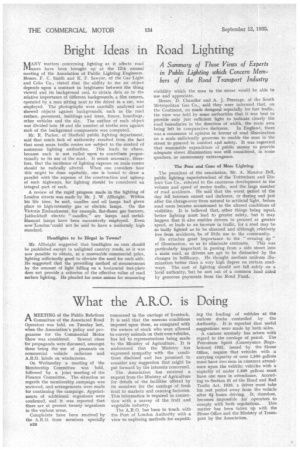Bright Ideas in Road Lighting
Page 36

If you've noticed an error in this article please click here to report it so we can fix it.
A Summary of Those Views of Experts in Public Lighting which Concern Mein hers of the Road Transport Industry
MANY matters concerning lighting as it affects road users have been brought up at the 12th annual meeting of the Association of Public Lighting Engineers. Messrs. F. C. Smith and K. F. Sawyer, of the Gas Light and Coke Co., stated that the ability to see an object depends upon a contrast in brightness between the -thing viewed and its background and, to obtain data as to the relative importance of different backgrounds, a film camera, operated by a man sitting next to the driver in a car, was employed. The photographs were carefully analysed and showed objects against backgrounds, such as the road surface, pavement, buildings and trees, fences, hoardings, other vehicles and the sky. The ontline of each object was divided into 10 and the number of tenths seen against each of the background components was computed.
Mr. R. Parker, of Sheffield public lighting department, said that much lack of uniformity resulted from the fact that most main traffic routes are subject to the control of numerous lighting authorities. This leads to chaos, because each is not called upon to contribute proportionally to its use of the road. It seems necessary, therefore, that the incidence of lighting expense on main routes should be radically altered. When one considers how this might be done equitably, one is bound to draw .a parallel with the expense of the construction and upkeep of such highways, for lighting should be considered an integral part of each.
A review of the rapid progress made in the lighting of London streets was made by Mr. J. W. Allbright. Within his life time, he said, candles and oil lamps had given place to high-intensity gas or electric lamps. On the Victoria Embankment, for example, flat-flame gas burners, Jablockhoff electric "candles," arc lamps and metalfilament lamps have been successively employed. Even now London`could not be said to have a uniformly high standard.
Headlights to be Illegal in Towns?
Mr. Allbright suggested that headlights on cars should be prohibited except in unlighted country roads, as it was now possible to obtain, at a reasonable commercial price, lighting sufficiently good to obviate the need for such aids. He suggested that the prevailing method of measurement by the amount of light falling on a horizontal test-plate does not provide a criterion of the effective value of road surface lighting. He pleaded for some means for measuring visibility which the man in the street would be able to use and appreciate.
Messrs. D. Chandler and A. J. Prestage, of the South Metropolitan Gas Co., said they were informed that, on the Continent, on roads designed especially for fast traffic, the view was held by some authorities that it was best to provide only just sufficient light to indicate clearly the road boundaries in the direction of width, the main area being left in comparative darkness. In England, there was a consensus of opinion in favour of road illumination on a scale sufficiently generous to enable the man in the street to proceed in comfort ad safety. It was regretted that reasonable expenditure of public money to provide adequate street illumination was still considered, in some quarters, as unnecessary extravagance.
The Pros and Cons of More Lighting.
The president of the association, Mr. A. Maurice Bell, public lighting superintendent of the Tottenham and District Gas Co., referred to the enormous development in the volume and speed of motor traffic, and the large number of road accidents. He said that the worst period of the day fell between sunset and darkness, or during and just after the change-over from natural to artificial light, before road users became accustomed to the altered conditions of visibility. It is believed that, other things being equal, better lighting must lead to greater safety, but it may happen that it also enables drivers to proceed at greater speed, or leads to an increase in traffic, for a road may be so badly lighted as to be shunned and although relatively free from accidents, be of little use to the community.
He attaches great importance to the "evening up" of illumination, so as to eliminate contrasts. This was particularly important in passing from a side street into a main road, as drivers are apt to be distracted by the changes in brilliancy. He thought medium uniform illumination better than a very high degree on certain roadways. The cost of lighting should not fall solely on a local authority, but be met out of a common fund aided by generous payments from the Road Fund.




















































































